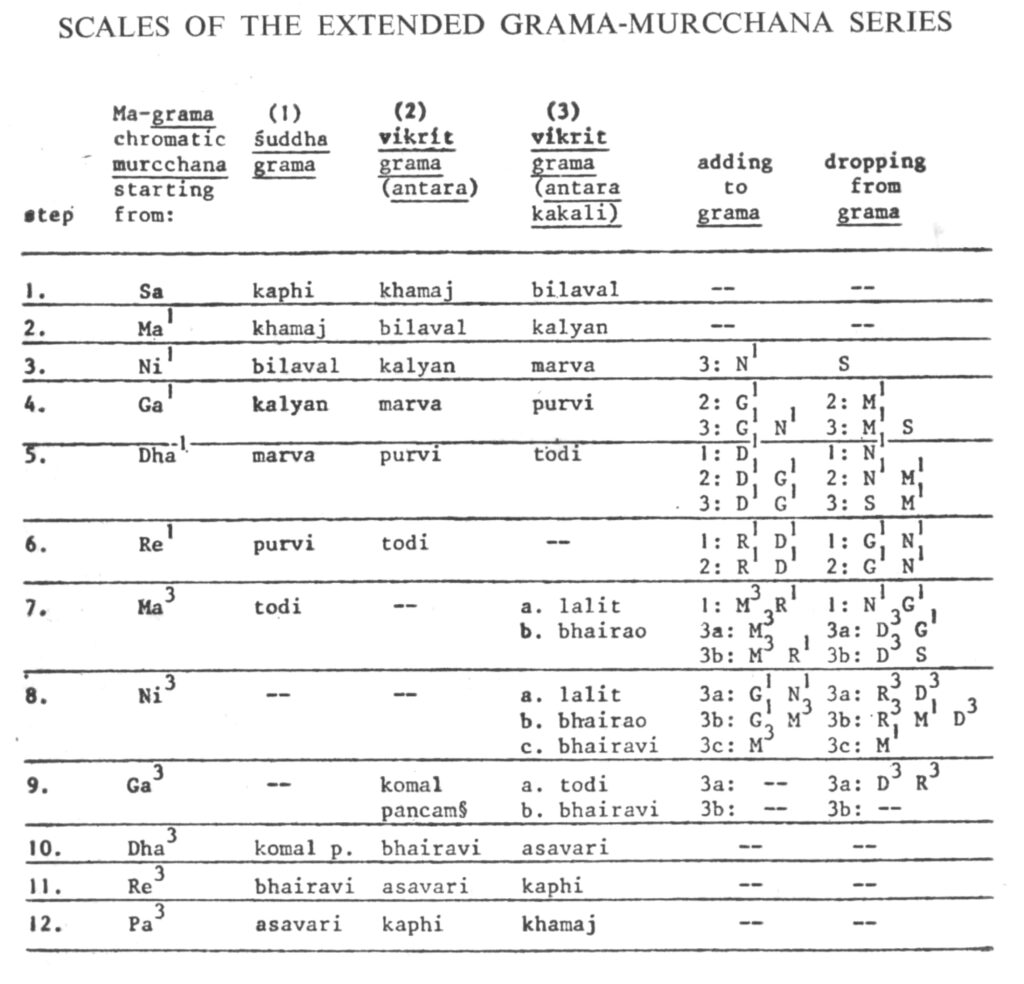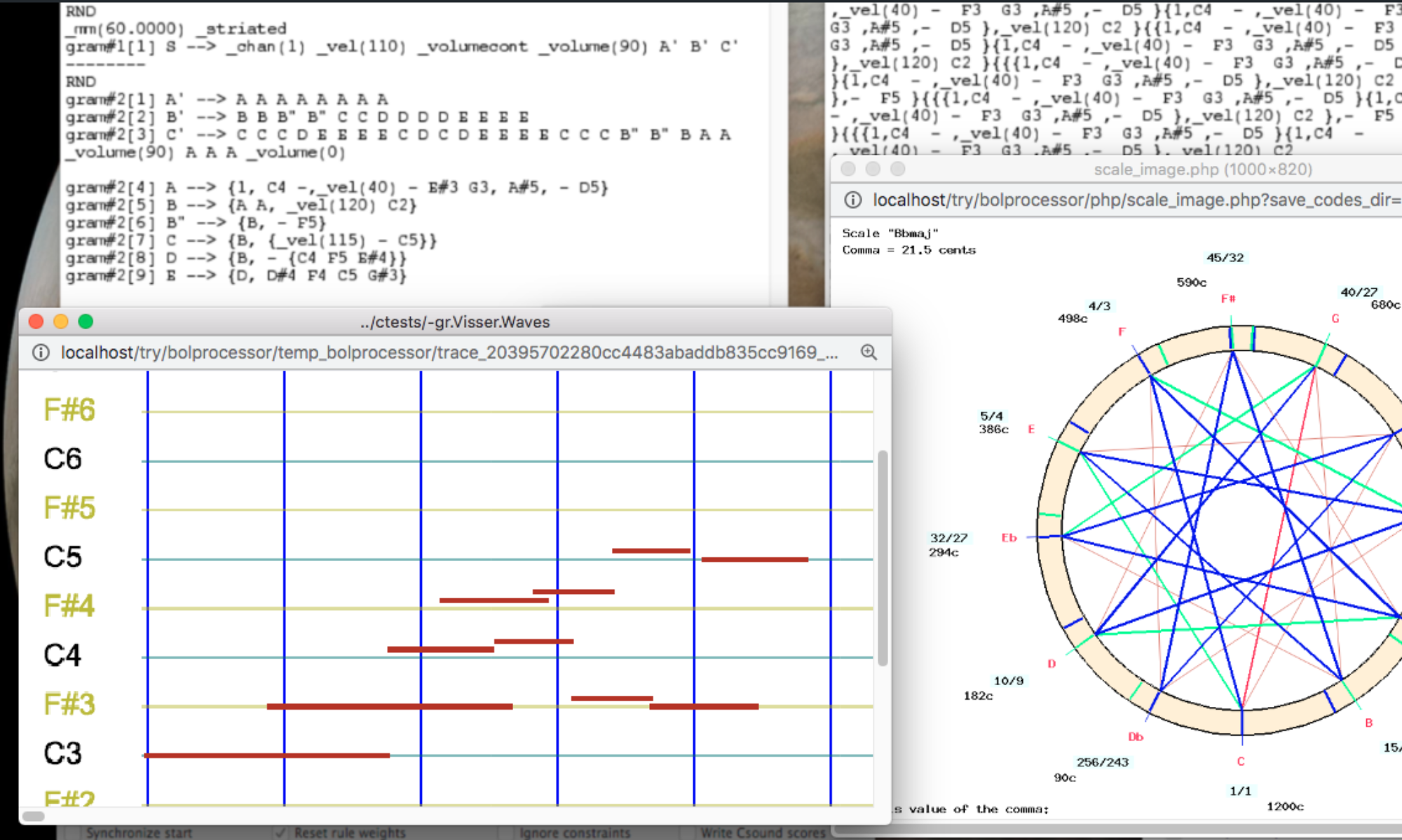E. James Arnold
Journal of the Sangit Natak Akademi, New Delhi 1982.
👉 Cited on page The two-vina experiment
Abstract
The first section of this paper considers the mathematical and musical principles by which the shruti positions (note positions in the system of "just intonation") are determined. A system of shorthand tuning symbols is given by which the tuning procedures for each of the shruti positions is concisely expressed. Using these symbols to summarize the appropriate tuning procedures, the positions of the shrutis are given in tables of families.
Then follows a description of a simple mathematical model of the shruti-swara-grama-murchana system of Bharata, Dattila, and Sharangadeva. A study of the harmonic structure of the gramas (fundamental scales) reveals that the principle scale-types employed in Hindustani classical music form a 'main-sequence' of scales directly relatable to the harmonic structure of the ancient gramas. This is summarized in a table of the 'extended murchana series' of scales derivable from the Ma and Sa gramas.
Excerpts of an AI review of this paper (Academia, June 2025)

This paper presents a rigorous mathematical framework for understanding one of the most complex and foundational concepts in Indian classical music theory: the ancient system of shrutis (microtonal intervals) and their relationship to scales (gramas) and melodic types (jatis). Arnold's work bridges the gap between abstract musicological theory and practical application through innovative mathematical modeling and visual representation.
Theoretical Foundation and Methodology
Arnold begins by addressing a fundamental challenge in Indian music theory: the precise determination of shruti positions within the octave. The traditional system recognizes 22 shrutis as the basic building blocks of melody, but their exact tuning has remained contentious among scholars and practitioners. The author develops an elegant shorthand notation system that concisely expresses tuning procedures for each shruti position, making complex intervallic relationships accessible through symbolic representation.
The paper's mathematical approach is grounded in just intonation principles, using frequency ratios derived from the harmonic series. Arnold systematically works through the mathematical relationships that define each shruti, presenting detailed tables that show the frequency ratios, periods, and harmonic relationships for different families of shruti positions. This methodical approach provides unprecedented clarity to what has historically been a murky area of music theory.
The Physical Model
One of the paper's most innovative contributions is the description of a physical model consisting of two rotating wheels: a fixed outer wheel representing shruti divisions and a movable inner wheel representing grama scales. This tangible device allows musicians and theorists to visualize the complex relationships between different scale types and their harmonic implications. The model serves as both an analytical tool and a practical calculator for determining intervallic relationships between any two shruti positions.
The wheel design reflects deep understanding of the cyclical nature of musical intervals and demonstrates how ancient Indian theorists like Bharata, Dattila, and Sharangadeva conceptualized harmonic relationships. By making these abstract concepts physically manipulable, Arnold provides an invaluable pedagogical tool for understanding classical Indian music theory.
Historical Integration and Validation
Arnold validates his mathematical model against the writings of ancient theorists, particularly focusing on the grama-murchana system described in classical treatises. The paper demonstrates how the principle scale-types used in contemporary Hindustani classical music can be traced back to these ancient harmonic structures, forming what Arnold terms a "main-sequence" of scales directly related to the fundamental gramas.
This historical grounding lends credibility to the mathematical framework while simultaneously providing new insights into the evolution of Indian musical practice. The paper shows how modern ragas maintain harmonic relationships with their ancient predecessors, despite centuries of stylistic development.
Practical Applications and Limitations
The model's practical utility extends beyond theoretical analysis to performance applications. Arnold suggests the system can help determine interval relationships, study melodic movement in ragas, and understand harmonic consonance patterns. However, the paper acknowledges important limitations, particularly noting that actual performance practice in Indian classical music involves constant microtonal adjustments rather than fixed frequency relationships.
This recognition of the difference between theoretical models and living musical practice demonstrates Arnold's nuanced understanding of Indian music. The author appropriately positions the mathematical framework as a tool for understanding structural principles rather than a prescription for performance practice.
Significance and Impact
Arnold's work represents a significant contribution to ethnomusicology and music theory, providing the first comprehensive mathematical model of the ancient Indian tonal system. The paper successfully demonstrates that rigorous analytical methods can illuminate traditional music systems without diminishing their cultural authenticity or practical flexibility.
The integration of historical scholarship, mathematical analysis, and practical application makes this work valuable for multiple audiences: music theorists seeking analytical frameworks, performers wanting deeper understanding of raga structure, and scholars of Indian culture exploring the mathematical sophistication of classical treatises.
While the paper's technical nature may limit its accessibility to general readers, its methodological innovations and theoretical insights establish it as essential reading for anyone seriously engaged with Indian classical music theory or comparative musicology.
